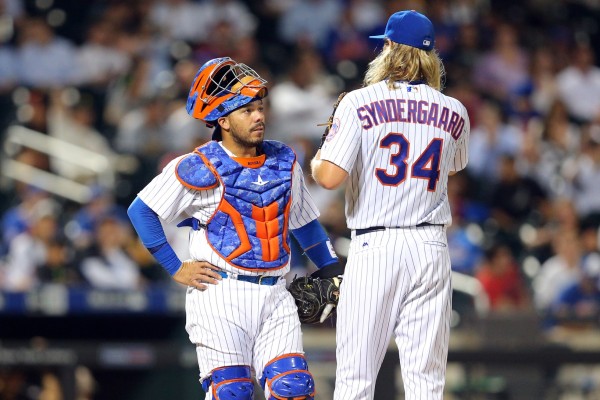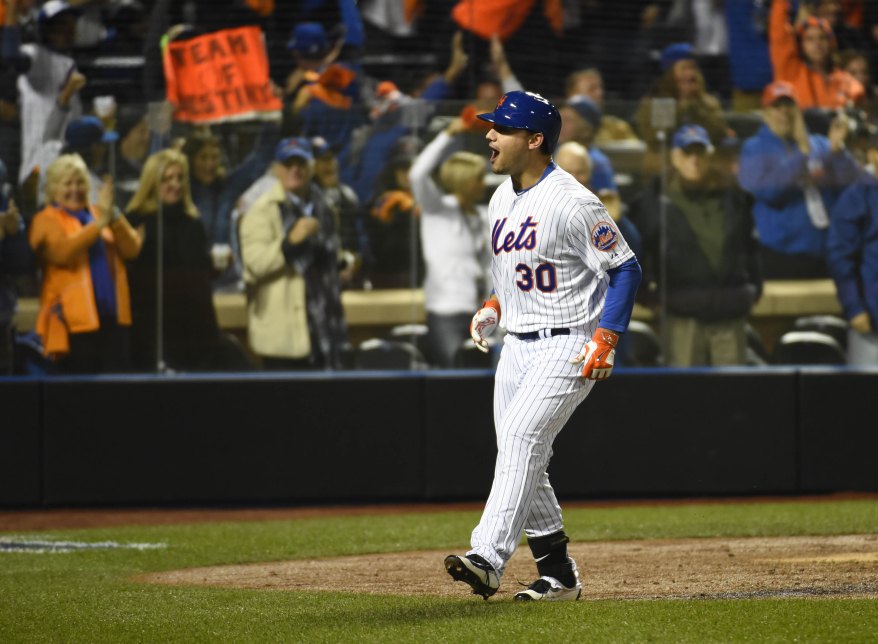
First it was Matt Harvey. Then Zack Wheeler. Then Jacob deGrom. Then Steven Matz. Then Harvey again. Finally, the mighty Noah Syndergaard fell. Even Robert Gsellman and Seth Lugo couldn’t avoid the plague of injuries that has befallen the Mets starting rotation over the last few years.
Position players haven’t been much healthier. Just this year, Yoenis Cespedes, Michael Conforto, Asdrubal Cabrera, Neil Walker, Lucas Duda, Travis d’Arnaud, and Juan Lagares have spent extended time on the disabled list.
Nonetheless, your best garden variety Mets excuse is invalid. Blaming injuries for the shocking plummet from World Series darlings with a budding rotation full of young superstars lets the Mets off the hook for the real reason they have crashed and burned their way to becoming a second-division team in 2017: Underperformance.
Now that it’s in the open, now that we’re no longer operating under the assumption that “God hates the Mets,” and that this team would be a definitive playoff team and potential juggernaut if not for a slew of injuries, the root of the problem can be addressed. The 2017 Mets are a disappointment because players they are counting on to be core members of the club are simply not as good as the team thought they would be.
For starters, Yoenis Cespedes has not performed anywhere near “franchise player” level this season, healthy or not. His 0.75 offensive WAR has him tied with Caleb Joseph for 163rd in MLB, just a few spots ahead of Jacob deGrom. To clarify, Cespedes has not been a tad bit more valuable than deGrom’s overall offensive contributions.
On the surface this seems to be an absurd notion, and to a certain extent it is: it’s not a fair comparison, as the two have exceedingly different talent levels at the plate. But the problem is, the expectation gap is just as wide, and rightly so. Cespedes is hitting just .217 with RISP and has no hits all season with two outs and RISP.
Nobody needs affirmation that Cespedes is a better hitter than deGrom, and Yoenis is certainly liable to have a monster second half, as he’s capable of three-week stretches that can be replicated by few other hitters in the league. But the first half of the season was essentially a total loss for the Mets $110 million man, who has even been a below-average left fielder in 2017, despite his Gold Glove acclaim.
Lucas Duda continues to chase and strike out too much, and it’s become clear that, as a hitter, he’s always going to be a “.240 with 25-30 HR” guy who gets on base around a .350 clip. He’s essentially an average Major League first baseman, and not the linchpin in the middle of the order that the Mets hoped he would become.
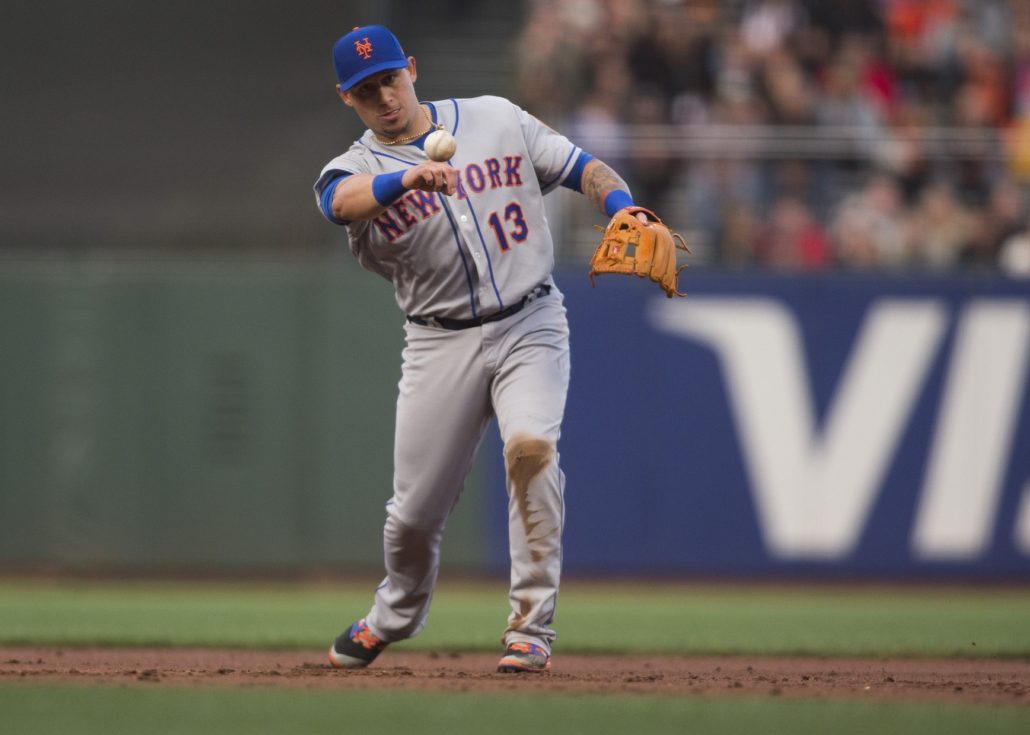
The struggles of Asdrubal Cabrera, coming off a season in which he was a delightful surprise defensively and produced one of the best offensive seasons of his career, have been well-documented. Cabrera has been one of the worst regulars in the league this season, playing below replacement level. He has regressed from his 2016 season in every single major offensive category and was so bad at shortstop, posting a ghastly .938 fielding percentage, that Jose Reyes, himself one of the worst players in the league, has bumped him to second base.
Whether it has been Reyes, Flores, or T.J. Rivera at the hot corner this season, the defense has been downright awful, and between Cabrera and Reyes at short, the left side has been an utter disaster. Jay Bruce is a mediocre defensive outfielder and Curtis Granderson is a defensive liability at any of the three outfield spots. Conforto’s defense has been below average this year, and Cespedes has been bad as I said.
Every single Mets regular is either having the single worst defensive season of his career, or is pretty close to it. Injuries don’t excuse this performance.
Another discouraging sign for the Mets future has been the performance of starting catcher Travis d’Arnaud, who has fallen into some sort of unpredictable platoon with career journeyman backup Rene Rivera because d’Arnaud continues to be maddeningly inconsistent. Travis hasn’t proven that he’s anything more than the .242/.307/.446 career slashline he has posted, and has particularly struggled getting on base this season, reaching at just a .282 clip. Once thought of as a potential stud catcher who would grow along with the young crop of “aces,” d’Arnaud may be nothing more than an average backup with some pop.
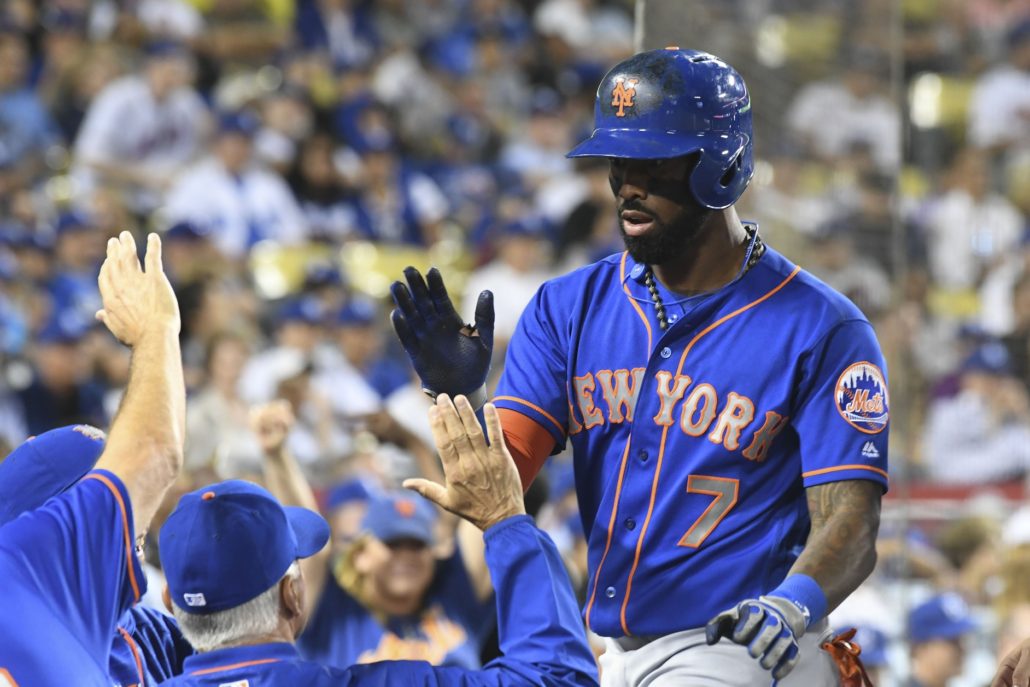
Reyes’ role on the team is laughable; the 2017 Mets are going nowhere and playing a 34-year-old who is slashing .215/.284/.370 despite a recent hot streak, while the No. 3 prospect in all of baseball continues to tear up Triple-A. This is a perfect representation of why the Mets fan base is perpetually perplexed and angry. Sandy Alderson is delusional if he feels that this is too high pressure of a time to bring up Amed Rosario because he’ll be seen as a “savior.” Most fans have given up on this season, and, if anything, will be relieved that they no longer need to shield their eyes every time a Mets shortstop steps to the plate or has a baseball hit in his direction.
And that’s before mentioning the pitching… The Mets own a 4.94 team ERA, third worst in the Majors.
The much-maligned bullpen seemed doomed to fail from the beginning of the season when Jeurys Familia was suspended for the first 15 games. Familia came back rusty and without the ability to throw strikes, and was nearly immediately diagnosed with a long-term injury. This was unpredictable and unfortunate.
Addison Reed and Jerry Blevins, with the exception of one tough stretch each, have been fantastic out of Terry Collins‘ bullpen. Nobody else has been passable.
Bringing back Fernando Salas was understandable, being that he was reliable for the Mets down the stretch last season. Continuing to run him out there as he gets drubbed nearly every time out while enduring the worst season of his career seems insane, but the other options aren’t pretty, either.
Hansel Robles underperformed to the point of demotion. Josh Smoker showed flashes but was generally horrendous, pitching to a 7.45 ERA. Josh Edgin wasn’t terrible in the first half but advanced metrics suggests he’s due for a rather large regression in the second half. Aside from one two-week stretch featuring a promising start and a couple solid relief outings, Rafael Montero has shown time and time again that he isn’t a major league pitcher. Neither is Neil Ramirez.
Paul Sewald has probably been the most encouraging reliever outside of Reed/Blevins, and will undoubtedly open the second half as the Mets most prominently featured right-handed middle reliever. He will have a chance to prove he is a legitimate piece of future Mets bullpens. Sewald has posted a 4.33 ERA, but his 2.95 FIP and 41 Ks in 35.1 innings with just 10 BB suggest that he might have run into some tough luck and could be on track for a second half surge.
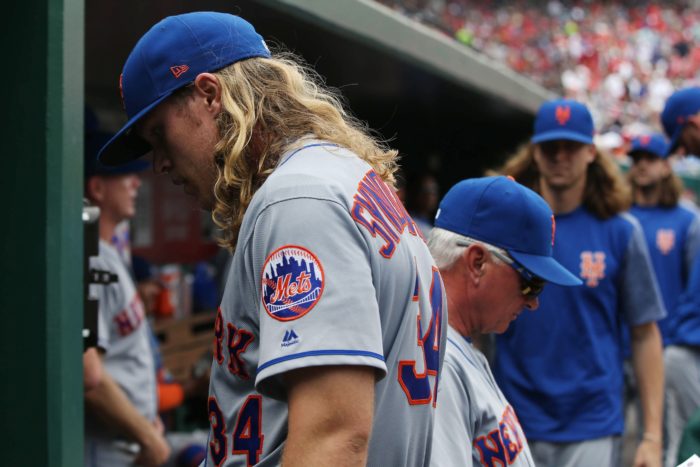
The rotation couldn’t afford to lose Syndergaard, and of course, that’s exactly what happened.
Both Matt Harvey‘s dreadful performance and subsequent DL stint were predictable at this point. Now 28 and just a year and a half from free agency, it’s unclear whether there’s any promise left in the former Dark Knight’s right arm.
Zack Wheeler‘s return season has been up and down, but disappointing overall, as while the right-hander has posted similar walk and strikeout rates to his 2014 campaign, but has been hit significantly harder. His 4.74 FIP is actually better than the team average, but clearly not what the Mets were looking for.
Steven Matz has, surprise surprise, pitched only 38.1 innings this season. As has always been the case with Matz, when he’s pitched, he’s been great, but he barely ever takes the mound. Status quo for Steven, who desperately needs to make 12-14 starts in the second half.
Robert Gsellman followed up his close-to sparkling 2016 with a dud of a first half, raising legitimate questions about whether his secondary stuff and command are good enough to make him a viable big league arm. His 6.16 ERA, 5.09 FIP and 97 hits allowed in 76 innings are not an encouraging piece of evidence toward answering that question.
Jacob deGrom has been rejuvenated this season, and he’s earned his 9-3 first half mark. His ERA stands at 3.65, but he’s been even better than that outside of two consecutive shellings in early June. deGrom is posting the highest strikeout rate of his career (10.5 K/9IP) and is one of baseball’s elite starting pitchers.
Conforto, deGrom, Bruce, Reed, Blevins, Granderson, Rene Rivera, T.J. Rivera, and Matz. These are the Mets who to some degree have met or exceeded expectations this season. Every other player has either regressed, been injured, or just wasn’t very good in the first place.
Before making excuses for the 2017 Mets, consider this: this team has had mediocre production at the catcher spot and first base, poor production at second, the worst left side of the infield in the game, and three outfielders who have been solid offensively—including All-Star Michael Conforto, and Jay Bruce. Despite a wretched start, Granderson has been who he is at this point in his career: a .230-.240 hitter who will find a way to hit 25 home runs.
Rene Rivera is the only Mets position player who has been an above average fielder this season. Their rotation and bullpen each rank among the league’s worst.
Make no mistake: this team has been beat up with crucial injuries, but this team isn’t losing because of that. This team is bad because the majority of the Mets who have taken the field in 2017 haven’t played anywhere close to a playoff level.
The result is that less than two years after winning the pennant, the Mets will need to strike gold as sellers at the trade deadline in order to replenish the talent level in the organization, and hope to compete in 2018. If the Mets want any hope of returning to the heights they reached in 2015, they won’t be able to afford playing key pieces who don’t play up to a Major League standard.


